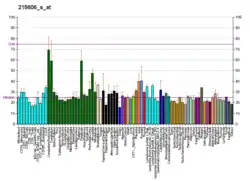ERC1
ELKS/RAB6-interacting/CAST family member 1 is a protein that in humans is encoded by the ERC1 gene.[5][6][7] The name ELKS is derived from "protein rich in the amino acids E, L, K and S"[8]
The protein encoded by this gene is a member of a family of RIM-binding proteins. RIMs are active zone proteins that regulate neurotransmitter release. This gene has been found fused to the receptor-type tyrosine kinase gene RET by gene rearrangement due to the translocation t(10;12)(q11;p13). Multiple transcript variants encoding different isoforms have been found for this gene.[7] ELKS has been reported to direct vesicles with RAB6A to melanosomes.[8]
References
- GRCh38: Ensembl release 89: ENSG00000082805 - Ensembl, May 2017
- GRCm38: Ensembl release 89: ENSMUSG00000030172 - Ensembl, May 2017
- "Human PubMed Reference:". National Center for Biotechnology Information, U.S. National Library of Medicine.
- "Mouse PubMed Reference:". National Center for Biotechnology Information, U.S. National Library of Medicine.
- Yokota T, Nakata T, Minami S, Inazawa J, Emi M (Apr 2000). "Genomic organization and chromosomal mapping of ELKS, a gene rearranged in a papillary thyroid carcinoma". J Hum Genet. 45 (1): 6–11. doi:10.1007/s100380050002. PMID 10697956.
- Monier S, Jollivet F, Janoueix-Lerosey I, Johannes L, Goud B (Apr 2002). "Characterization of novel Rab6-interacting proteins involved in endosome-to-TGN transport". Traffic. 3 (4): 289–97. doi:10.1034/j.1600-0854.2002.030406.x. PMID 11929610. S2CID 22993226.
- "Entrez Gene: ERC1 ELKS/RAB6-interacting/CAST family member 1".
- Patwardhan A, Bardin S, Miserey-Lenkei S, Larue L, Goud B, Raposo G, Delevoye C (2017). "Routing of the RAB6 secretory pathway towards the lysosome related organelle of melanocytes". Nature Communications. 8: 15835. doi:10.1038/ncomms15835. PMC 5474736. PMID 28607494.
Further reading
- Nakajima D, Okazaki N, Yamakawa H, et al. (2003). "Construction of expression-ready cDNA clones for KIAA genes: manual curation of 330 KIAA cDNA clones". DNA Res. 9 (3): 99–106. doi:10.1093/dnares/9.3.99. PMID 12168954.
- Armour JA, Crosier M, Jeffreys AJ (1992). "Human minisatellite alleles detectable only after PCR amplification". Genomics. 12 (1): 116–24. doi:10.1016/0888-7543(92)90413-M. PMID 1733848.
- Nakata T, Kitamura Y, Shimizu K, et al. (1999). "Fusion of a novel gene, ELKS, to RET due to translocation t(10;12)(q11;p13) in a papillary thyroid carcinoma". Genes Chromosomes Cancer. 25 (2): 97–103. doi:10.1002/(SICI)1098-2264(199906)25:2<97::AID-GCC4>3.0.CO;2-L. PMID 10337992.
- Kikuno R, Nagase T, Ishikawa K, et al. (1999). "Prediction of the coding sequences of unidentified human genes. XIV. The complete sequences of 100 new cDNA clones from brain which code for large proteins in vitro". DNA Res. 6 (3): 197–205. doi:10.1093/dnares/6.3.197. PMID 10470851.
- Nakata T, Yokota T, Emi M, Minami S (2002). "Differential expression of multiple isoforms of the ELKS mRNAs involved in a papillary thyroid carcinoma". Genes Chromosomes Cancer. 35 (1): 30–7. doi:10.1002/gcc.10095. PMID 12203787. S2CID 21891794.
- Wang Y, Liu X, Biederer T, Südhof TC (2002). "A family of RIM-binding proteins regulated by alternative splicing: Implications for the genesis of synaptic active zones". Proc. Natl. Acad. Sci. U.S.A. 99 (22): 14464–9. doi:10.1073/pnas.182532999. PMC 137906. PMID 12391317.
- Strausberg RL, Feingold EA, Grouse LH, et al. (2003). "Generation and initial analysis of more than 15,000 full-length human and mouse cDNA sequences". Proc. Natl. Acad. Sci. U.S.A. 99 (26): 16899–903. doi:10.1073/pnas.242603899. PMC 139241. PMID 12477932.
- Ko J, Na M, Kim S, et al. (2004). "Interaction of the ERC family of RIM-binding proteins with the liprin-alpha family of multidomain proteins". J. Biol. Chem. 278 (43): 42377–85. doi:10.1074/jbc.M307561200. PMID 12923177.
- Ota T, Suzuki Y, Nishikawa T, et al. (2004). "Complete sequencing and characterization of 21,243 full-length human cDNAs". Nat. Genet. 36 (1): 40–5. doi:10.1038/ng1285. PMID 14702039.
- Deguchi-Tawarada M, Inoue E, Takao-Rikitsu E, et al. (2004). "CAST2: identification and characterization of a protein structurally related to the presynaptic cytomatrix protein CAST". Genes Cells. 9 (1): 15–23. doi:10.1111/j.1356-9597.2004.00697.x. PMID 14723704. S2CID 13337267.
- Ducut Sigala JL, Bottero V, Young DB, et al. (2004). "Activation of transcription factor NF-kappaB requires ELKS, an IkappaB kinase regulatory subunit". Science. 304 (5679): 1963–7. doi:10.1126/science.1098387. PMID 15218148. S2CID 29198955.
- Jin J, Smith FD, Stark C, et al. (2004). "Proteomic, functional, and domain-based analysis of in vivo 14-3-3 binding proteins involved in cytoskeletal regulation and cellular organization". Curr. Biol. 14 (16): 1436–50. doi:10.1016/j.cub.2004.07.051. PMID 15324660. S2CID 2371325.
- Gerhard DS, Wagner L, Feingold EA, et al. (2004). "The status, quality, and expansion of the NIH full-length cDNA project: the Mammalian Gene Collection (MGC)". Genome Res. 14 (10B): 2121–7. doi:10.1101/gr.2596504. PMC 528928. PMID 15489334.
- Rual JF, Venkatesan K, Hao T, et al. (2005). "Towards a proteome-scale map of the human protein-protein interaction network". Nature. 437 (7062): 1173–8. doi:10.1038/nature04209. PMID 16189514. S2CID 4427026.
- Beausoleil SA, Villén J, Gerber SA, et al. (2006). "A probability-based approach for high-throughput protein phosphorylation analysis and site localization". Nat. Biotechnol. 24 (10): 1285–92. doi:10.1038/nbt1240. PMID 16964243. S2CID 14294292.
- Ewing RM, Chu P, Elisma F, et al. (2007). "Large-scale mapping of human protein-protein interactions by mass spectrometry". Mol. Syst. Biol. 3 (1): 89. doi:10.1038/msb4100134. PMC 1847948. PMID 17353931.
This article is issued from Wikipedia. The text is licensed under Creative Commons - Attribution - Sharealike. Additional terms may apply for the media files.




